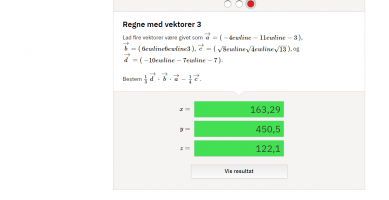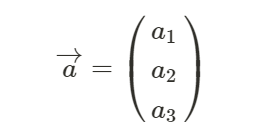Nemanjavuk69
Junior Member
- Joined
- Mar 23, 2022
- Messages
- 67
Homework description
Let there be fours vectors.
[math]\vec{A} = \begin{pmatrix} -4 \\ -11 \\ -3 \end{pmatrix} \vec{B} = \begin{pmatrix} 6 \\ 6 \\ 3 \end{pmatrix} \vec{C} = \begin{pmatrix} \sqrt{8} \\ \sqrt{4} \\ \sqrt{13} \end{pmatrix} \vec{D} = \begin{pmatrix} -10 \\ -7 \\ -7 \end{pmatrix}[/math]
The equation to be solved is as follow...
[math]\frac{1}{3}\cdot\vec{D}\cdot \vec{B} \cdot \vec{A} - \frac{1}{4}\cdot \vec{C}[/math]
Actual solution
I know for a fact, that I should end up with a new 3D-vector, and that new 3D-vector has the X, Y, Z coordinates as followed (Numbers have been rounded doing the calculations)...
[math]\vec{E} = \begin{pmatrix} 163.29 \\ 450.5 \\ 122.1 \end{pmatrix}[/math]
My solution and question.
However, when I calculate, I end up with [math]\vec{E} = \begin{pmatrix} 330.38 \\ 231.17 \\ 231.57 \\ \end{pmatrix}[/math]So my question is, where am I going wrong?
My approach
What I know so far, is that when we deal with 3D-vectors, we deal with them as with ordinary 2D-vectors.
I know that I can use a constant [math]k[/math] and simply multiply it with all the vectors coordinates like this [math]\vec{TEST} \begin{pmatrix} k\cdot x \\ k\cdot y \\ k\cdot z \\ \end{pmatrix}[/math]I also know, that you can not "multiply" two vectors as normal, therefore I have to use the dot-product (I think you might call it something else), which says I have to multiply the first vectors x-coordinate with the second vectors x-coordinate and add it to the first vectors y-coordinate and multiply it with the second vectors y-coordinate and add it to the first vectors z-coordinate and multiply it with the second vectors z-coordinate. I looks something like this
[math](\vec{A_x} \cdot \vec{B_x}) + (\vec{A_y} \cdot \vec{B_y}) + (\vec{A_z} \cdot \vec{B_z})[/math]This returns a number, AND NOT A VECTOR.So, fair enough, I use this knowledge (which I hopefully understood correctly) and apply it to the equation.
I start from left to right, since there are no parenthesis. So I say the 1/3 (constant) fraction multiplied by the vector D which gives me a new vector with the values [math]\begin{pmatrix} -3.33 \\ -2.33 \\ -2.33 \\ \end{pmatrix}[/math]I then do the dot-product between vector B and A which gives me [math]-99[/math].
I then further proceed to use that number and multiply it on my new vector, which gives me [math]\begin{pmatrix} 329.67 \\ 230.67 \\ 320.67 \end{pmatrix}[/math].
This is then where I stop, since there is no point in doing the last minus operation, since my answer even after the last operation will not even come close to the actual solution. This leads me to think, that perhaps there is an order of operation when dealing with vectors?
Ps. I am not entirely sure if this is the right board to post my question
Let there be fours vectors.
[math]\vec{A} = \begin{pmatrix} -4 \\ -11 \\ -3 \end{pmatrix} \vec{B} = \begin{pmatrix} 6 \\ 6 \\ 3 \end{pmatrix} \vec{C} = \begin{pmatrix} \sqrt{8} \\ \sqrt{4} \\ \sqrt{13} \end{pmatrix} \vec{D} = \begin{pmatrix} -10 \\ -7 \\ -7 \end{pmatrix}[/math]
The equation to be solved is as follow...
[math]\frac{1}{3}\cdot\vec{D}\cdot \vec{B} \cdot \vec{A} - \frac{1}{4}\cdot \vec{C}[/math]
Actual solution
I know for a fact, that I should end up with a new 3D-vector, and that new 3D-vector has the X, Y, Z coordinates as followed (Numbers have been rounded doing the calculations)...
[math]\vec{E} = \begin{pmatrix} 163.29 \\ 450.5 \\ 122.1 \end{pmatrix}[/math]
My solution and question.
However, when I calculate, I end up with [math]\vec{E} = \begin{pmatrix} 330.38 \\ 231.17 \\ 231.57 \\ \end{pmatrix}[/math]So my question is, where am I going wrong?
My approach
What I know so far, is that when we deal with 3D-vectors, we deal with them as with ordinary 2D-vectors.
I know that I can use a constant [math]k[/math] and simply multiply it with all the vectors coordinates like this [math]\vec{TEST} \begin{pmatrix} k\cdot x \\ k\cdot y \\ k\cdot z \\ \end{pmatrix}[/math]I also know, that you can not "multiply" two vectors as normal, therefore I have to use the dot-product (I think you might call it something else), which says I have to multiply the first vectors x-coordinate with the second vectors x-coordinate and add it to the first vectors y-coordinate and multiply it with the second vectors y-coordinate and add it to the first vectors z-coordinate and multiply it with the second vectors z-coordinate. I looks something like this
[math](\vec{A_x} \cdot \vec{B_x}) + (\vec{A_y} \cdot \vec{B_y}) + (\vec{A_z} \cdot \vec{B_z})[/math]This returns a number, AND NOT A VECTOR.So, fair enough, I use this knowledge (which I hopefully understood correctly) and apply it to the equation.
I start from left to right, since there are no parenthesis. So I say the 1/3 (constant) fraction multiplied by the vector D which gives me a new vector with the values [math]\begin{pmatrix} -3.33 \\ -2.33 \\ -2.33 \\ \end{pmatrix}[/math]I then do the dot-product between vector B and A which gives me [math]-99[/math].
I then further proceed to use that number and multiply it on my new vector, which gives me [math]\begin{pmatrix} 329.67 \\ 230.67 \\ 320.67 \end{pmatrix}[/math].
This is then where I stop, since there is no point in doing the last minus operation, since my answer even after the last operation will not even come close to the actual solution. This leads me to think, that perhaps there is an order of operation when dealing with vectors?
Ps. I am not entirely sure if this is the right board to post my question
Last edited:


